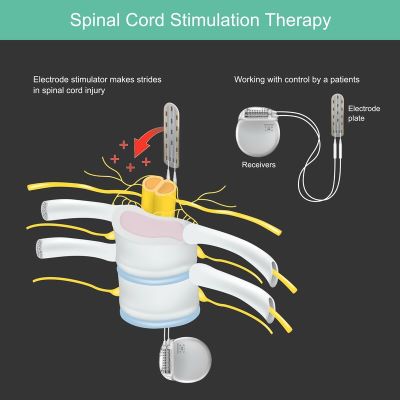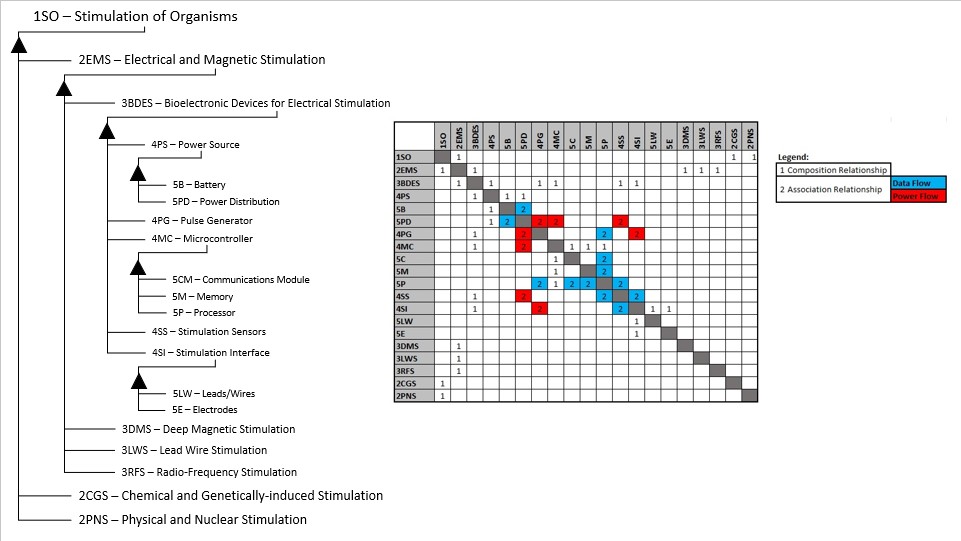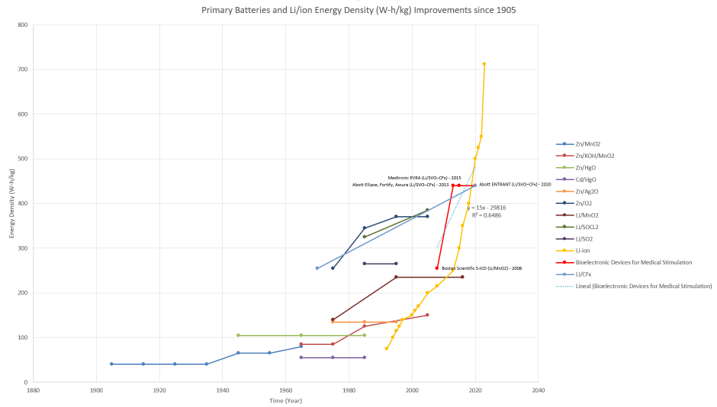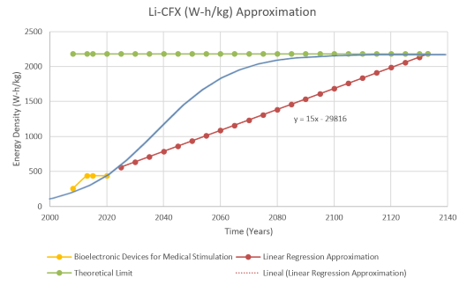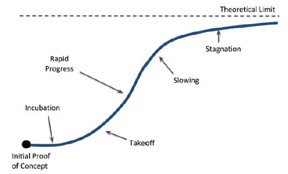Difference between revisions of "Bioelectronic Devices for Electrical Stimulation"
| Line 75: | Line 75: | ||
[3] National Library of Medicine. (2023, September 18). Retrieved from: https://www.ncbi.nlm.nih.gov/pmc/articles/PMC6057139/ | [3] National Library of Medicine. (2023, September 18). Retrieved from: https://www.ncbi.nlm.nih.gov/pmc/articles/PMC6057139/ | ||
----- | |||
[1] "A 700W·h·kg−1 Rechargeable Pouch Type Lithium Battery", Li, Yang, Yu, et al.(2023, March 17). DOI: 10.1088/0256-307X/40/4/048201 | |||
[2] "Thermodynamic analysis on energy densities of batteries", Zu, Li. (2015, December 15). DOI: 10.1039/c0ee00777c | |||
[3] "The Center for Reasearch on Extreme Batteries", Wachsman, Lundgren, Takeuchi, et al. (2017, June 08) | |||
[4] Boston Scientific EMBLEM™ MRI S-ICD System. (2023, October 11). Retrieved from: https://www.bostonscientific.com/en-US/products/defibrillators/emblem-s-icd-system.html?gclid=Cj0KCQjw7JOpBhCfARIsAL3bobdBU-CKnhwnED4aMLrr9joyzbZ9NrlBnYyE5coTh2iVZZMdqv5b0kEaAgsdEALw_wcB | |||
[5] Entrant™ Dual-Chamber ICD. (2023, October 11). Retrieved from: https://www.cardiovascular.abbott/content/dam/cv/cardiovascular/hcp/products/cardiac-rhythm-management/entrant-icd/documents/crm-entrant-dual-chamber-icd-order-info-us.PDF | |||
[6] Entrant™ Single-Chamber ICD. (2023, October 11). Retrieved from: https://www.cardiovascular.abbott/content/dam/cv/cardiovascular/hcp/products/cardiac-rhythm-management/entrant-icd/documents/crm-entrant-icd-single-chamber-order-info-us.PDF | |||
[7] Medtronic - EVERA MRI XT Family Datasheets. (2023, October 11). Retrieved from: https://www.medtronic.com/us-en/healthcare-professionals/products/cardiac-rhythm/icd-systems/evera-mri.html | |||
[8]Abott - ICD Family. (2023, October 11). Retrieved from: https://operativa.sk/wp-content/uploads/2020/10/crm_product_catalog-ICD.pdf | |||
[9] "High-Energy and High-Power Primary Li-CFx Batteries Enabled by the Combined Effects of the Binder and the Electrolyte", Huo, Radhakrishnan, Shaw. (2023, May 9th) https://doi.org/10.3390/batteries9050268 | |||
[10] "Pushing the theoretical limit of Li–CFx batteries using fluorinated nanostructured carbon nanodiscs", Ahmad, Dubois, Guérin, et al. (2015, November) https://doi.org/10.1016/j.carbon.2015.07.073 | |||
[11] Olivier L. de Wek, Technology Roadmapping and Development, 1st Edition, Springer. (2022) | |||
Revision as of 04:05, 12 October 2023
Technology Roadmap Sections and Deliverables
The Bioelectronic Devices for Electrical Stimulation [3BDES] is a level 3 technology roadmap focused around electrically stimulating biological systems (e.g., muscles, nerves, cells) for clinical purposes. A roadmap will be developed to explore the current status of the technology and the potential venues of progress from both a technical and business side.
Roadmap Overview
Bioelectronic Medicine is a novel approach that combines molecular medicine, neuroscience, and bioengineering to threaten and diagnose diseases and injuries. Bioelectronic devices can read and modulate electrical activity within the body. These devices open new possibilities and alternatives to diagnose and treat real-time diseases by using electrical pulses to restore health instead of chemical and biological drugs. In the literature, Bioelectronic Medicine can be found as neuromodulation, biostimulation, or electroceuticals. [1] [2] [3]
The bioelectronic devices that delivers electrical stimulation and dominate the market are:
- Implantable Cardioverter Defibrillators (ICD)
- Cardiac Pacemakers (CP)
- Cochlear Implants (CI)
- Spinal Cord Stimulators (SCS)
- Deep Brain Stimulators (DBS)
- Sacral Nerve Stimulators (SNS)
- Transcutaneous Electrical Nerve Stimulators (TENS)
- Vagus Nerve Stimulators
Below is an example use case of a stimulator used for the spinal cord:
Design Structure Matrix (DSM) Allocation
The above breakdown of the technology shows different potential roadmaps of consideration within the wider Organism Stimulation level 1 roadmap. Since the technology that was selected is generic in nature (i.e. no particular target organism for stimulation), alternative venues of implementation such as chemical stimulation can be compared in the future. The enabling technologies are listed under the roadmap of interest (3BDES): Power Source (4PS: to power the electronic components), Pulse Generator (4PG: to emit the electric signals), Microcontroller (4MC: to receive, analyze, control the pulse generator, and communicate with an external device), Stimulation Sensors (4SS: to sense feedback signals from the target organism), and Stimulation Interfaces (4SI: to interface directly with the organism). The level 4 and 5 technologies within the 3BDES roadmap are interrelated by power flows and data flows as shown.
Roadmap Model using OPM
Provided below is an OPD and OPL of the 3BDES roadmap. The OPM shows the components that make up the device, their Figures of Merit (FOMs), and the functions that take place to stimulate the bio-signal and change its states.
Figures of Merit
The table below lists the different FOMs that can be assessed for this technology roadmap. They are allocated by component (note that Telemetry refers to the Communications Module, assumed to be integrated into the Microcontroller).
In the two figures below, the team sketched approximately the timeline and modeled the rate of improvement of Energy Density by using a linear regression and S shape (Manually). With the current data, the technology's improvement rate is 1.326 [W-h/kg] per year. [1] [2] [3] [4] [5] [6] [7] [8]
"The Li-CF𝑥 primary battery was commercialized in 1970. It offers many advantages such as a high energy and high-power density, excellent shelf-life, applicability in a wide temperature range (−60 to +60 °C), and a relatively easy-to-source and economic composition" [9]. This is why companies such as Abbott and Medtronic use these batteries instead of the Li/MNO2 batteries that Boston Scientific uses in their current products. Therefore, the primary assumption for this analysis is that the Li-CFx batteries will dominate battery technology for a long time. However, as seen from the previous graph, battery technologies do not fully progress through the S curve, as in the case of Li-ion technology, since usually, a new technology disrupts the current composition and pushes the technology forward with a new battery composition. This is evident if we analyze the red line, which jumps drastically from 255 (W-h/kg) to 440 (W-h/kg). Also, according to the presented data, the Li/MnO2 composition has stagnated in the past two decades, while the Li-CFx composition has improved over the same time.
The theoretical limit for Li-CFx batteries can be determined by analyzing the battery's chemical composition. "Fluorinated carbons (CFx) ... may deliver a maximum theoretical capacity of 865 mAh/g when used as electrode material in a primary lithium battery [1–6]. This capacity corresponds to the overall electrochemical conversion of C–F bonds into amorphous carbon. Indeed, in a primary lithium battery, the electrochemical process in a fluorinated carbon electrode involves the breaking of one C–F bond by supplying an electron from the external circuit" [10]. Therefore, the theoretical limit of the Li-CFx technology is 2,180 Wh/kg when graphite is fully fluorinated. [9]
Using the figures above with the S-Curve reference as shown below [11], we estimate that the current technology is in the "Takeoff" stage. The reason is that the rate of improvement for the Li-CFx has not slowed down since 1970 compared to other primary batteries that stagnated over time. In addition, other battery compositions have not had a different increase in energy density than the Li-CFx. These reasons along with the high theoretical limits show that the battery still has much to offer, which means improvements in the service life of bioelectronic devices' technology. However, even if the theoretical limit is five times the capacity that we have today, it is most likely that a new lithium composition will take over Li-CFx as seen in the history of batteries over the years shown in the first figure above.
Alignment with Company Strategic Drivers
XXX
Positioning of Company vs. Competition
XXX
Technical Model
XXX
Financial Model
References
[1] Feinstein Institutes for Medical Research. (2023, September 18). Retrieved from: https://feinstein.northwell.edu/institutes-researchers/bioelectronic-medicine
[2] PNAS. (2023, September 18). Retrieved from: https://www.pnas.org/doi/10.1073/pnas.1919040116
[3] National Library of Medicine. (2023, September 18). Retrieved from: https://www.ncbi.nlm.nih.gov/pmc/articles/PMC6057139/
[1] "A 700W·h·kg−1 Rechargeable Pouch Type Lithium Battery", Li, Yang, Yu, et al.(2023, March 17). DOI: 10.1088/0256-307X/40/4/048201
[2] "Thermodynamic analysis on energy densities of batteries", Zu, Li. (2015, December 15). DOI: 10.1039/c0ee00777c
[3] "The Center for Reasearch on Extreme Batteries", Wachsman, Lundgren, Takeuchi, et al. (2017, June 08)
[4] Boston Scientific EMBLEM™ MRI S-ICD System. (2023, October 11). Retrieved from: https://www.bostonscientific.com/en-US/products/defibrillators/emblem-s-icd-system.html?gclid=Cj0KCQjw7JOpBhCfARIsAL3bobdBU-CKnhwnED4aMLrr9joyzbZ9NrlBnYyE5coTh2iVZZMdqv5b0kEaAgsdEALw_wcB
[5] Entrant™ Dual-Chamber ICD. (2023, October 11). Retrieved from: https://www.cardiovascular.abbott/content/dam/cv/cardiovascular/hcp/products/cardiac-rhythm-management/entrant-icd/documents/crm-entrant-dual-chamber-icd-order-info-us.PDF
[6] Entrant™ Single-Chamber ICD. (2023, October 11). Retrieved from: https://www.cardiovascular.abbott/content/dam/cv/cardiovascular/hcp/products/cardiac-rhythm-management/entrant-icd/documents/crm-entrant-icd-single-chamber-order-info-us.PDF
[7] Medtronic - EVERA MRI XT Family Datasheets. (2023, October 11). Retrieved from: https://www.medtronic.com/us-en/healthcare-professionals/products/cardiac-rhythm/icd-systems/evera-mri.html
[8]Abott - ICD Family. (2023, October 11). Retrieved from: https://operativa.sk/wp-content/uploads/2020/10/crm_product_catalog-ICD.pdf
[9] "High-Energy and High-Power Primary Li-CFx Batteries Enabled by the Combined Effects of the Binder and the Electrolyte", Huo, Radhakrishnan, Shaw. (2023, May 9th) https://doi.org/10.3390/batteries9050268
[10] "Pushing the theoretical limit of Li–CFx batteries using fluorinated nanostructured carbon nanodiscs", Ahmad, Dubois, Guérin, et al. (2015, November) https://doi.org/10.1016/j.carbon.2015.07.073
[11] Olivier L. de Wek, Technology Roadmapping and Development, 1st Edition, Springer. (2022)
